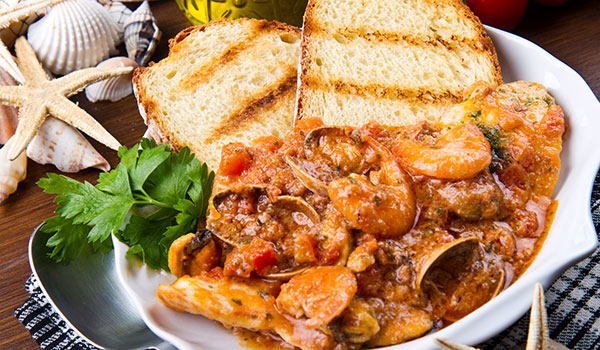
Until a few years ago, the Marche could be considered a predominantly agricultural region. Farm produce was mostly for local family consumption, and along the coast, the sea offered its riches to the fishermen. Industrialisation has here maintained respect for the environment and the countryside, the Marche people have not abandoned their own style: life here, like the food, is generally sober, civil and simple. The gastronomic culture in this region consists of few elements, that are simple, but rich in flavour: pork, sheep, rabbit and poultry accompanied the daily life of the farmers, and good wine and excellent olive oil are never missing from the tables of the Marche people. Plenty of vegetables, wheat for home-made bread, and fruits that vary according to the season, have always ensured that there is always something to eat. The biggest fuss, however, was made for pork, the true, great wealth of the farming family. Beef was rare, oxen were used as working animals, and even today, the Marches cow can be considered a pride of this land, as it is one of the few, valued breeds of cow in Italy. Meats are cooked in many different ways, potacchio and in porchetta just to mention two. The first is characterised by the presence of crushed garlic, rosemary and white wine, whilst cooking in porchetta sees the use of wild fennel, which is very common in Marche cooking, and used for several dishes. Of course, while speaking about the gastronomic culture of this land, there are two jewels of the region that we absolutely cannot forget: the white truffle and the formaggio di fossa (a cave-matured, sheep’s milk cheese). The white truffle, (tuber magnatum pico) matures in the autumn. It has an extraordinary, unique and unmistakable aroma that makes it instantly recognisable. The formaggio di fossa comes from a centuries-old tradition. The cheese is made in the summer, and then allowed to mature for a long period of time inside natural, cool and dry pits (or caverns), where a singular transformation, involving significant changes in flavour and odour, takes place. If we move along the Adriatic coast we find the triumph of the seafood cooking. The sea provides homes for many varieties of fish, and the fishermen know how to adapt to every situation. Common fish and simple dishes are served for everyday meals, whilst richer fish and more sumptuous dishes can be provided for special occasions. Brodetto is the noble dish of the coast, from the North to the South, with variations which enrich and distinguish it. Its origins are in the working class, and it comes from the ability of the fishermen to use the fish that couldn’t be offered on the market. With time, the dish has been refined, gaining fame throughout Italy. Today it is presented in many different versions. Are there twelve varieties of fish or thirteen? Should you use saffron or not? Should the sauce be thick or liquid? Should the bread that accompanies this dish be toasted or not? Everyone talks about it, everyone prepares it in their own way, to suit their own, personal, tastes. That is how the Marche is: long live diversity!


